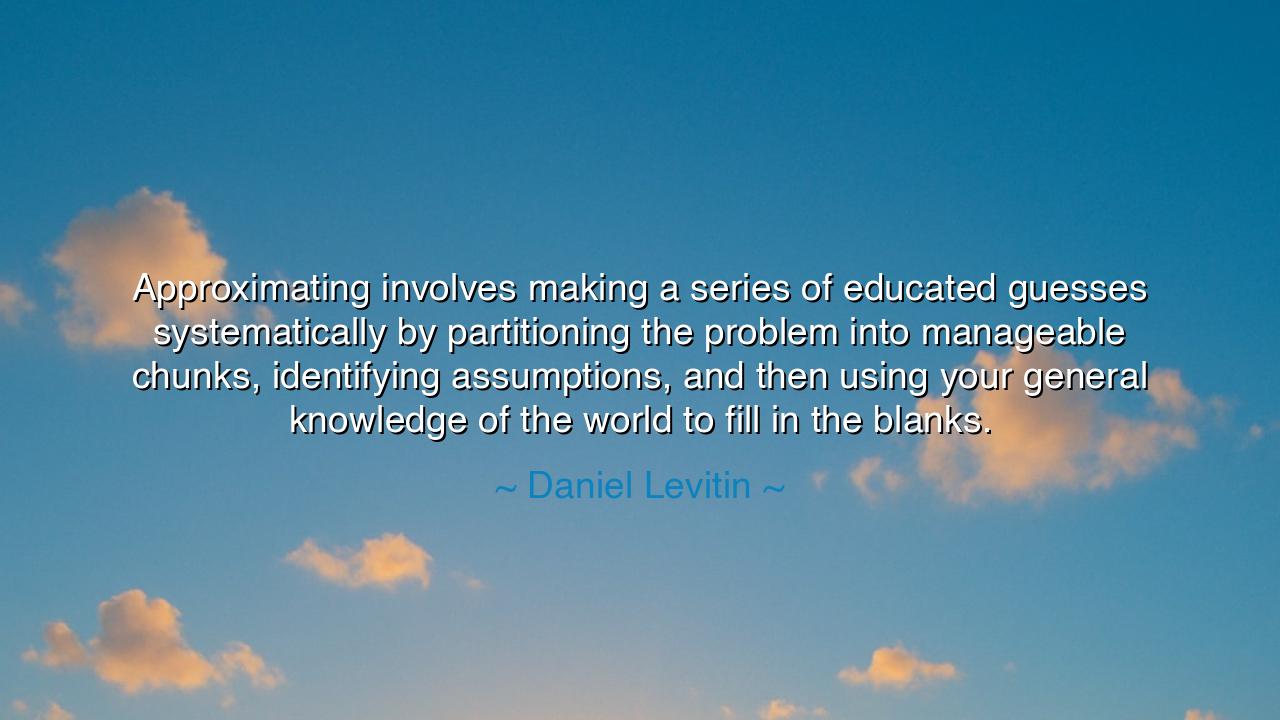
Approximating involves making a series of educated guesses
Approximating involves making a series of educated guesses systematically by partitioning the problem into manageable chunks, identifying assumptions, and then using your general knowledge of the world to fill in the blanks.






The words of Daniel Levitin — “Approximating involves making a series of educated guesses systematically by partitioning the problem into manageable chunks, identifying assumptions, and then using your general knowledge of the world to fill in the blanks” — are more than a lesson in reasoning. They are a meditation on the very art of understanding — a reminder that wisdom is not found in perfection, but in clarity born of humility. In this, Levitin speaks as the philosophers of old once did: not of numbers and formulas alone, but of the mind’s discipline, the capacity to approach the unknown with courage, curiosity, and structure. His words remind us that truth, like the horizon, can be seen more clearly when one steps forward patiently, piece by piece, rather than demanding to see all at once.
To approximate is to engage with reality as it is — vast, complex, and often beyond exact comprehension. The ancients knew this well. When the mathematicians of Alexandria or the astronomers of Babylon sought to measure the heavens, they did not despair at their limits; they built methods to approach truth gradually. Theirs was not a reckless guessing, but a disciplined imagination — the sacred balance between intuition and logic. So too does Levitin teach us to divide what overwhelms us into smaller pieces, to seek order in the chaos by partitioning the problem into manageable chunks. This is not only a method of science — it is a way of life. For every great challenge, from building a civilization to healing a broken heart, must be met in steps, not leaps.
He speaks also of educated guesses, and therein lies the nobility of the human mind. To guess, but to do so wisely — this is the mark of intelligence. For wisdom does not demand omniscience, but awareness. The wise do not claim to know all things; they know how to reason from what is known to what is hidden. They admit their assumptions, as Levitin counsels, and they test them, adjusting as the light of truth grows clearer. It is this humility, this willingness to acknowledge uncertainty, that separates wisdom from arrogance. The fool demands certainty in all things; the sage works with what he has and builds understanding through patience and discernment.
History offers many examples of this principle in motion. Consider Eratosthenes, who, over two thousand years ago, measured the circumference of the Earth without leaving Egypt. He could not see the whole, but he approximated — reasoning from the shadows of two cities and the known distance between them. He partitioned the problem, made his assumptions, and filled the blanks with logic and observation. His answer was not perfect, but astonishingly close to truth — a triumph of the human intellect over the limits of perception. In that act, Eratosthenes embodied Levitin’s wisdom: that knowledge grows not through certainty, but through thoughtful approximation.
Yet the lesson extends beyond science into the very fabric of existence. Life itself is filled with uncertainties, with questions that no formula can fully solve. We cannot know the hearts of others completely, nor predict the turns of fate, nor see the full shape of our destiny. But we can approximate wisely. We can divide our fears into smaller truths, acknowledge what we assume, and use our general knowledge of the world — our memories, our intuition, our experience — to find our way forward. Thus, the art of approximation becomes the art of living: an act of courage amid mystery, a steady walk through the fog of the unknown.
Levitin’s teaching is also a call to balance intellect with humility. In an age where many boast of certainty, he reminds us that progress is born of imperfection. The world’s greatest inventions, from the compass to the computer, began not with absolute answers but with careful estimates, refined through time. To approximate is to accept that the journey toward truth is endless, but worthy. It is to stand, as the explorers of old did, at the edge of the map and venture onward, trusting that each educated guess brings us closer to light.
The lesson of this quote, therefore, reaches deep into the soul: do not fear the unknown because you cannot measure it exactly. Begin with what you know, divide the impossible into the possible, and move step by step. Admit your assumptions — for honesty is the foundation of wisdom — and use your knowledge of the world to guide your course. Whether you are solving a problem of numbers, navigating grief, or seeking meaning, remember that the path to truth is not a straight line but a spiral of approximations, each bringing you closer to understanding.
So let these words be your guide, as they were to the thinkers and builders of every age: truth is not seized in a single grasp — it is approached, refined, and revealed to the patient. Make your guesses, but make them with thought. Divide your burdens, but bear them with strength. Fill in the blanks not with fear, but with faith in reason and experience. For the one who learns to approximate wisely will never be lost in uncertainty — they will walk the earth as a seeker, guided always by the light of understanding that grows with every step.






AAdministratorAdministrator
Welcome, honored guests. Please leave a comment, we will respond soon